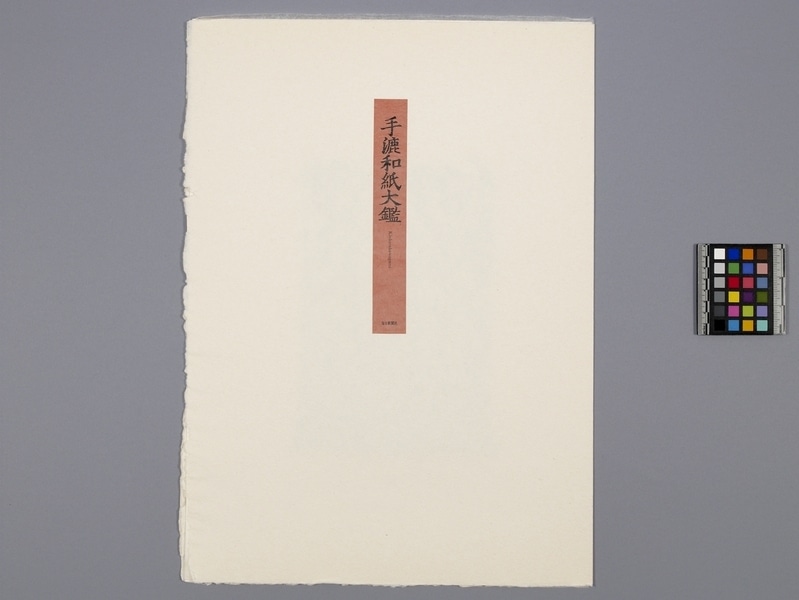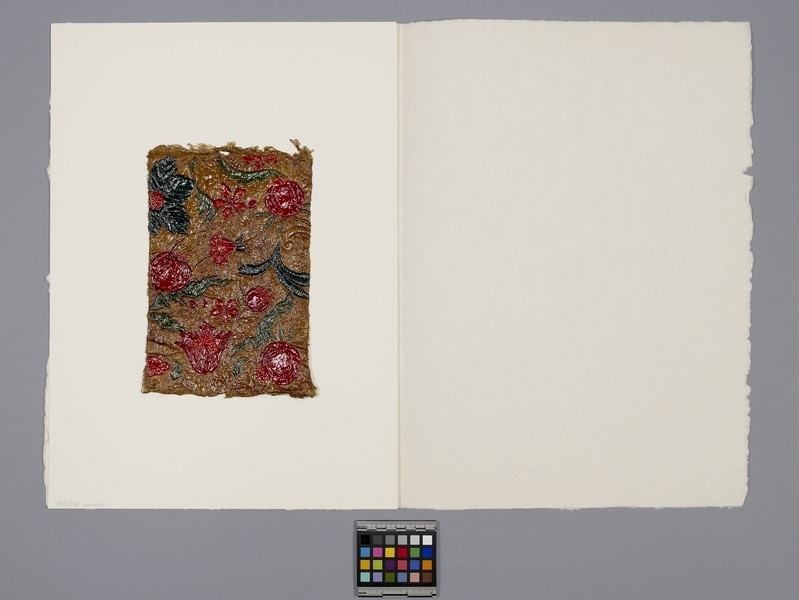Paper Item Number: Ed5.2121 a-b from the MOA: University of British Columbia


Description
Fibrous, course, uneven sheet (a) with thickly- painted yellow brown design of fruit(?), flowers and leaves: randomly-placed relief design is green and dark green leaves, three round red objects, each capped with a seed cluster, two flowers with orange petals, and two red cup-like flowers, one large, one small, each with seed clusters at centre. Yellow brown ground has ribbed texture and appearance, and shows reliefs of vines and leaves, dark brown in recesses of paper. Sample pasted to plain, thick white mount, sample information printed on back. Protected by rectangular piece of white covering gauze and folder (b): thick, heavy, roughened, yellow white paper, folded over, flap opening from left, all edges retaining an irregular deckle edge. Brown rectangular strip on front has black printing of paper name in Japanese and English.
History Of Use
Papermaking originated on the Asian mainland and spread to Japan by 1500 years ago. For centuries Japan has produced the greatest quantity and variety of handmade paper or washi in the world. Traditionally, papermaking was a family or community enterprise which thrived in mountain farming communities where cold, pure water and wild bast fibre shrubs, such as mulberry, are plentiful. Washi is an important cultural symbol and holds a place in nearly every aspect of Japanese life. It is also a significant aspect of both Shinto and Buddhist rites and customs. Originally, design carved in low relief and painted gold on tanned deerskin or other hide. Imported by early European traders and produced in Japan during Edo Period (1600-1867 C.E.). In Meiji Era (1868-1911 C.E.), paper imitations for wallpaper began to be made. This sample type made by artist since 1970 for inkstone cases, hand-boxes, bags, handbags, and various kinds of handiwork.
Cultural Context
sample
Narrative
This is part of the Tesukiwashi Taikan, a collection of handmade paper published, in an edition of 1000 copies, in Tokyo as a project to commemorate the centennial of Mainchi Newspapers and to preserve Japanese handmade paper. A collection on this scale had not been made before. This collection consists of 5 boxes of mounted and labelled samples with an explanatory book in 4 of the boxes. The text is in Japanese and with less detail, in English. Compiled and edited by a special editorial staff of scholars. Published by the Mainchi Newspapers of Tokyo, Japan.
Item History
- Made by Seikichiro Goto (Maker) in Shizuoka, Japan before 1974
- Collected during 1977
- Owned by Yoshihisa Okamatsu before March 23, 1977
- Received from Yoshihisa Okamatsu (Donor) on March 23, 1977
What
- Name
- Paper
- Identification Number
- Ed5.2121 a-b
- Type of Item
- paper
- Overall
- height 50.6 cm, width 37.0 cm
Who
- Culture
- Japanese
- Creator
- Seikichiro Goto (Maker)
- Previous Owner
- Yoshihisa Okamatsu
- Received from
- Yoshihisa Okamatsu (Donor)
Where
- Holding Institution
- MOA: University of British Columbia
- Made in
- Shizuoka, Japan
When
- Creation Date
- before 1974
- Collection Date
- during 1977
- Ownership Date
- before March 23, 1977
- Acquisition Date
- on March 23, 1977
Other
- Item Classes
- works on paper
- Condition
- good
- Accession Number
- 0369/0033 a-b